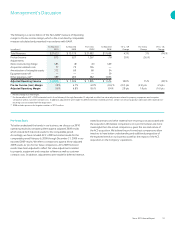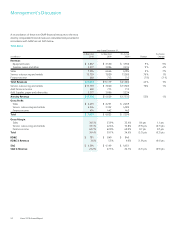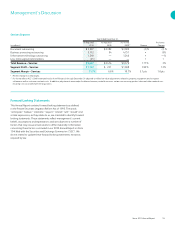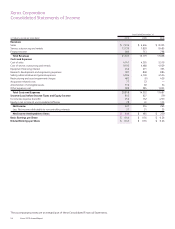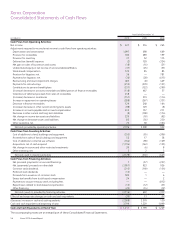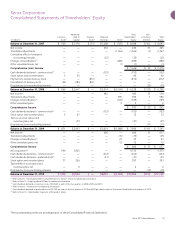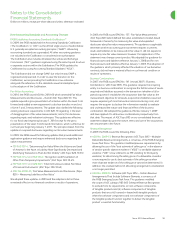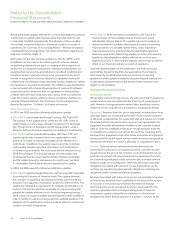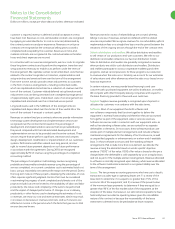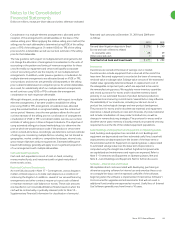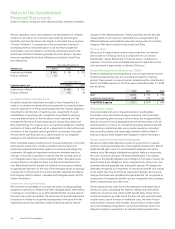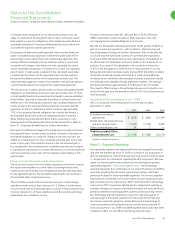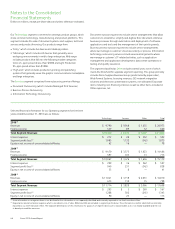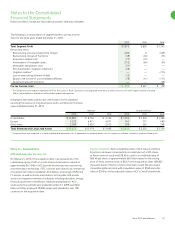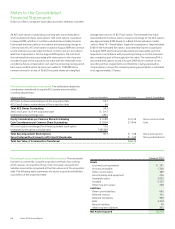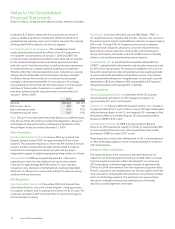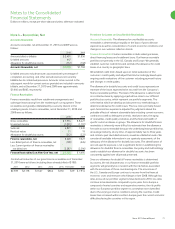Xerox 2010 Annual Report Download - page 63
Download and view the complete annual report
Please find page 63 of the 2010 Xerox annual report below. You can navigate through the pages in the report by either clicking on the pages listed below, or by using the keyword search tool below to find specific information within the annual report.
Notes to the Consolidated
Financial Statements
Dollars in millions, except per-share data and unless otherwise indicated.
61Xerox 2010 Annual Report
customer is required, revenue is deferred until all acceptance criteria
have been met. Revenues on cost-reimbursable contracts are recognized
by applying an estimated factor to costs as incurred, determined by
the contract provisions and prior experience. Revenues on unit-price
contracts are recognized at the contractual selling prices as work is
completed and accepted by the customer. Revenues on time-and-
material contracts are recognized at the contractual rates as the labor
hours and direct expenses are incurred.
In connection with our services arrangements, we incur costs to originate
these long-term contracts and to perform the migration, transition and
setup activities necessary to enable us to perform under the terms of
the arrangement. We capitalize certain incremental direct costs that are
related to the contract origination or transition, implementation and
setup activities and amortize them over the term of the arrangement.
From time to time, we also provide certain inducements to customers
in the form of various arrangements, including contractual credits,
which are capitalized and amortized as a reduction of revenue over the
term of the contract. Customer-related deferred set-up/transition and
inducement costs are being amortized over a weighted average period
of approximately eight years. Initial direct costs of an arrangement are
capitalized and amortized over the contractual service period.
Long-lived assets used in the fulfillment of the arrangements are
capitalized and depreciated over the shorter of their useful life or the
term of the contract if an asset is contract-specific.
Revenues on certain fixed price contracts where we provide information
technology system development and implementation services are
recognized over the contract term based on the percentage of
development and implementation services that are provided during
the period compared with the total estimated development and
implementation services to be provided over the entire contract. These
services require that we perform significant, extensive and complex
design, development, modification or implementation of our customers’
systems. Performance will often extend over long periods, and our
right to receive future payment depends on our future performance
in accordance with the agreement. During 2010, we recognized
approximately $270 of revenue using the percentage-of-completion
accounting method.
The percentage-of-completion methodology involves recognizing
probable and reasonably estimable revenue using the percentage of
services completed, on a current cumulative cost to estimated total cost
basis, using a reasonably consistent profit margin over the period. Due to
the long-term nature of these projects, developing the estimates of costs
often requires significant judgment. Factors that must be considered
in estimating the progress of work completed and ultimate cost of the
projects include, but are not limited to, the availability of labor and labor
productivity, the nature and complexity of the work to be performed
and the impact of delayed performance. If changes occur in delivery,
productivity or other factors used in developing the estimates of costs
or revenues, we revise our cost and revenue estimates, which may result
in increases or decreases in revenues and costs, and such revisions are
reflected in income in the period in which the facts that give rise to that
revision become known.
Revenues earned in excess of related billings are accrued, whereas
billings in excess of revenues earned are deferred until the related
services are provided. We recognize revenues for non-refundable, upfront
implementation fees on a straight-line basis over the period between the
initiations of the ongoing services through the end of the contract term.
Sales to distributors and resellers: We utilize distributors and resellers
to sell certain of our products to end-user customers. We refer to our
distributor and reseller network as our two-tier distribution model.
Sales to distributors and resellers are generally recognized as revenue
when products are sold to such distributors and resellers. Distributors
and resellers participate in various cooperative marketing and other
programs, and we record provisions for these programs as a reduction
to revenue when the sales occur. Similarly, we account for our estimates
of sales returns and other allowances when the sales occur based on our
historical experience.
In certain instances, we may provide lease financing to end-user
customers who purchased equipment we sold to distributors or resellers.
We compete with other third-party leasing companies with respect to
the lease financing provided to these end-user customers.
Supplies: Supplies revenue generally is recognized upon shipment or
utilization by customers in accordance with the sales terms.
Software: Most of our equipment has both software and
non-software components that function together to deliver the
equipment’s essential functionality and therefore they are accounted
for together as part of the equipment sales or services revenues.
Software accessories sold in connection with our equipment sales, as
well as free-standing software sales, are accounted for as separate
deliverables or elements. In most cases, these software products are
sold as part of multiple-element arrangements and include software
maintenance agreements for the delivery of technical service, as well
as unspecified upgrades or enhancements on a when-and-if-available
basis. In those software accessory and free-standing software
arrangements that include more than one element, we allocate the
revenue among the elements based on vendor-specific objective
evidence (“VSOE”) of fair value. VSOE of fair value is based on the price
charged when the deliverable is sold separately by us on a regular basis
and not as part of the multiple-element arrangement. Revenue allocated
to software is normally recognized upon delivery, while revenue allocated
to the software maintenance element is recognized ratably over the
term of the arrangement.
Leases: The two primary accounting provisions which we use to classify
transactions as sales-type or operating leases are: 1) a review of the
lease term to determine if it is equal to or greater than 75% of the
economic life of the equipment; and 2) a review of the present value
of the minimum lease payments to determine if they are equal to or
greater than 90% of the fair market value of the equipment at the
inception of the lease. Our leases in our Latin America operations have
historically been recorded as operating leases given the cancellable
nature of the contract or because the recoverability of the lease
investment is deemed not to be predictable at lease inception.


